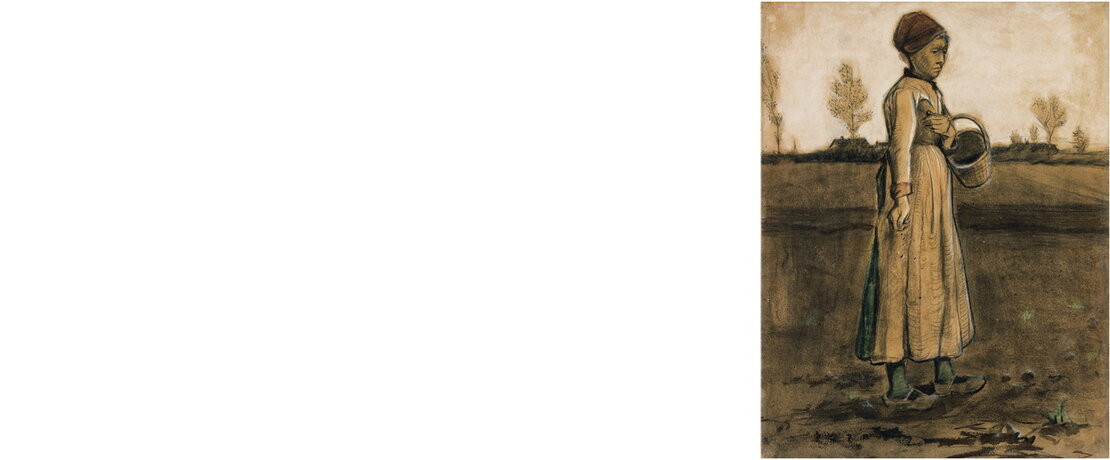Record for van Gogh
With considerable records, top prices and a total result of almost 10 million euros, Lempertz can look back on a weekend of successful sales. The highlight of the auction was Vincent van Gogh's work in black chalk and watercolour “Femme semant”/“Peasant woman sowing with a basket” from 1881, which sold for €1.036 mill. This important early work thus became the most valuable and important water-coloured drawing by this artist to be sold on the German auction market for decades

The unusually large work on paper (measuring 62 x 47 cm) is subtly tinted with watercolour paint and was made in the autumn of 1881 in Etteren near Breda, where Van Gogh's father was pastor and where the young artist lived at this time. The piece is the only known example of this motif of a lady sowing seeds in the fields, and the rare early work was loaned to the 1988 exhibition “Van Gogh and Millet” in the Rijksmuseum Vincent van Gogh in Amsterdam. The watercolour picks up on the motif of farm work, which was of central importance to the young Van Gogh. The piece depicts the peasant woman with great dignity and earnest. The life and work of farmers was to retain central importance in Van Gogh's oeuvre: He continued to paint motifs of sowing and harvest as allegories of the cycle of life and death throughout his career (lot 304, est. €800-900,000).
Giovanni Giacometti is represented with an expressive, vividly coloured self–portrait from 1916. Giacometti's oeuvre contains numerous portraits. As the setting for this piece he chose a place before a window where his head was prominently back lit. The room appears to be the artist's studio, as a painting is depicted to his left. The intense colouring exemplified in this self–portrait is typical of Giacometti's painted oeuvre. The canvas was purchased for €310,000 (lot 301, est. €240–290,000).
The stylistic plurality exemplified in Cuno Amiet's “Blumenstillleben” was a quality both admired and criticised by contemporaries, and can be placed somewhere between the works of Giovanni Giacometti and Ferdinand Hodler. The artist was closely acquainted with the former since 1887, met the latter in 1893 and met Giovanni Segantini, who he also held in high esteem, in 1896. Amiet became a member of the Dresden artist group ‘Die Brücke’ in 1905, and got to know the ‘Blaue Reiter’ circle in Munich in 1911. Divisionism, Cloisonism and Symbolism were the defining movements of the era, and the artist moved between them with ease. The present floral still life was made in 1908 and has remained in private ownership in an undisclosed location for over 100 years, and will now once again be on view to the public following its rediscovery by Lempertz. The canvas attracted numerous bidders, and was eventually purchased by a Swiss art dealer against strong competition for €173,600 (lot 302, est. €80–120,000).
Leonard Foujita's 1926 canvas “Nu assoupi, Youki”, was purchased by a Chinese bidder for €198.400. The long-lost work, which was exhibited in France in 2010, belongs to a series of large-format portraits and nudes on white ground which the artist painted in the second half of the 1920s. The piece is an excellent example of Foujita's elegant mixing of traditional Japanese art – in its technique, mindset and history – with the European avant-garde and Art Deco influences (lot 322, est. €100–150,000).
A German collector was able to take home Wilhelm Morgner's 1913 work “Komposition mit Feldarbeiter”, with its fascinating contrasts between abstraction and objectivity, for €173,600. The artist was strongly influenced by Van Gogh from very early on in his career, but it was his close affinity to the protagonists of the ‘Blaue Reiter’ group that most affected his work after 1912. At this point, Morgner was already a well respected artist, but in 1913 at the age of just 22 he was to make his last oil paintings. After voluntarily enlisting to fight in WWI, he fell in the summer of 1917. Like his contemporaries Marc and Macke, Morgner also left behind an unusually developed and multi-facetted oeuvre despite his early passing (lot 315, est. €120–150,000).
Otto Mueller's “Sitzendes Mädchen am Wasser” was also highly sought-after. The piece, dated 1920, was once kept in the Folkwang Museum in Essen. The original estimate of
€40–50,000 was more than doubled, with the work selling to a German art dealer for €109,000. The subject of the nude in a landscape can be found frequently in Otto Mueller's oeuvre. Like the works of his fellow “Brücke” artists, his pieces also express the contemporary ideals of the “Lebensreform” Movement and its ideal of man's return to a paradisiacal state in harmony with nature (lot 317). Heinrich Campendonk's gouache “Zwei Radfahrer in Landschaft” from 1913/14, one of the artist's most important periods, sold to a German art dealer for €93,000. In the intersection of the lively, abstract composition the outlines of two cyclists overlap, creating a futuristic suggestion of movement and a feeling of floating and lightness (lot 312, est. €80–100,000).
Renée Sintenis' frequently exhibited bronze “Großes grasendes Fohlen” from 1929 also sold to a German art dealer for €86.800. Horses and ponies feature in almost half of the artist's 125 bronze figures of animals. She made a small, earlier version of this piece in 1919, reiterating the motif in a slightly differing form 10 years later in the 76.3 cm figure “Grosses grasendes Fohlen” (Large Grazing Foal), working the physiognomic details with characteristic care (lot 312, est. €80–100,000).
Karl Schmidt-Rottluff's “Osterstrauss aus dem Jahr 1947” was sold to an English bidder for €99,000 (lot 335, est. €80–90,000). Maurice de Vlaminck's canvas “Rue de Village” from around 1926-1927 changed hands for €74,400 (lot 305, est. €60–80,000). “Loslösung II” by Edvard Munch from 1896 climbed from the estimate of €30–40,000 to achieve €62,000 (lot 300). Max Slevogt was represented by a Sicilian landscape from 1914, which achieved €43,400 (lot 308, est. €30–35,000).
